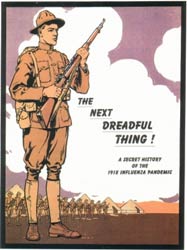Novel

The Next Dreadful Thing
Download The Next Dreadful Thing (.pdf)
Summary
In September of 1918, Brian McCullough is shipped back to Boston to recuperate from a war wound. World War One, The Great War, is almost at an end. Brian expects to be re-united with his wife and daughter and put the horrors of the war behind him, but he finds that his fight has only just begun.
The army base and surrounding Boston Area becomes infected by an unknown epidemic. Doctors puzzle over patients who come down with fever, then slowly suffocate in their own beds as their lungs full with a watery fluid. The cause of death is eventually identified as influenza, but it is unlike any strain ever seen. Death comes in 12 hours after the first symptoms appear.
Brian searches for answers, and finds clues that hint at government conspiracy of vast proportion. Could it be that the virus was manufactured by the government to fight the Germans, and that the war is being won, not by tanks and rifles, but by a disease too tiny to be analyzed by the most sophisticated microscopes?
Together, with his friend, William Pinkerton, head of the famous Pinkerton Detective Agency, Brian tries desperately to stop the pandemic before it claims all he holds dear. The clock is ticking, and the only hope rests with a vaccine that army intelligence denies, but that he knows exists!
The Starving Writer’s Notes
Ebola, HIV, biological warfare . . .
These words send a shiver up our spines.
Popular fiction on viruses have explored the possibilities with bestsellers like Stephen King’s The Stand or Michael Crichton’s The Andromeda Strain. Films, in turn, have adapted these bestsellers for the screen or developed original blockbusters like “Outbreak” and “Mission Impossible II.”
But as the old cliche goes — the truth is even stranger than fiction.
The Influenza Epidemic of 1918 killed approximately 25 million people worldwide. Over 600,000 died in the United States alone — more than all the nation’s combat deaths in the last century combined. A majority of the human species was infected. It stands as the second most deadly pandemic in recorded history, second only to the infamous Black Death of the 14th century.
But unlike other cases of mass death (The Black Death or the Jewish Holocaust), the Influenza Epidemic of 1918 remained a footnote in history. For some reason, this important historical event was wiped from the popular consciousness.
Public Interest in the subject of the 1918 Influenza Epidemic has grown in the last two years. Perhaps because of the AIDs virus or the growing international concern over biological warfare the threat of a viral disaster has taken prominence in the popular imagination as the most likely doomsday scenario since the Cold War. A documentary film, “Influenza 1918,” by PBS, came out in 1999 to wide praise. It was followed shortly thereafter by a book adaptation. Gina Bari Kolata’s Flu: The Story of the Great Influenza Pandemic and the Search for the Virus That Caused It (also nonfiction) was published in November 1999, fueling even more interest. In October of 2000, two more nonfiction books on the subject made it to the shelf; The Purple Death: The Flu of 1918, by David Getz, and The Devil’s Flu, by Pete Davies.
